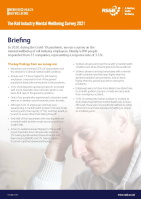How is the mental health of rail employees?
In 2020, during the Covid-19 pandemic, we ran a survey on the mental wellbeing of rail employees. Nearly 4,000 people responded, and the results have identified key activities which will improve mental health across the industry.
The aim of the survey was to examine the prevalence of anxiety, depression, and post-traumatic stress disorders, in rail employees and determine factors which can improve their mental health. The findings demonstrate an association between several important factors and mental health outcomes across depression, anxiety, and post-traumatic stress disorders.
More than one in three (43%) respondents met criteria for a clinical mental health condition. Symptoms that are indicative of depression were most frequently reported, with 38% of respondents demonstrating scores in the moderate to severe range. Moderate to severe symptoms of anxiety were reported by 29% of participants.
The results showed poor mental health experienced by rail employees has increased since the Covid-19 pandemic began. This increase is consistent with the trend observed in the general population - moderate-severe depression has increased from 5.6% to 31.6% and moderate-severe anxiety has increased from 6% to 18.8%.
Our results revealed that rail employees experienced 1.5 times higher rate of anxiety compared to the rates seen in the general population. This may be partly due to differences in survey methodology, however this could also be related to the challenges of working in public facing roles and increased pressure during the pandemic. Most staff in public-facing roles (96%) reported having had access to personal protective equipment, which may have helped protect against anxiety in roles with perceived exposure to Covid-19. At the same time, one in three of all participants reported an increase in work pressures during the pandemic.
Of the respondents, 41% reported that they experienced a traumatic event, with 74% describing at least some of these events as work-related. 10% of all participants reported symptoms consistent with a clinical post-traumatic stress disorder, with 7% reporting symptoms consistent with Complex Post-Traumatic Stress Disorder (C-PTSD) and 3% consistent with post-traumatic stress disorder (PTSD). This is over double the rate found in the general population. The higher rate of C-PTSD is indicative of the impact of repeated exposure to traumatic events, characteristic of trauma-exposed work.
What factors impact mental wellbeing?
-
Are employees being supported?
Despite the prevalence of poor mental health, only half of participants had sought help.
Access to evidence-based therapy for those who met the criteria for a post-traumatic stress disorder was low, with only 2% having Eye Movement Desensitization and Reprocessing (EMDR) and 5% having trauma-focussed cognitive behavioural therapy.
-
How does poor mental health impact performance?
Not only did this survey reveal the impact of poor mental on rail employees, but it showed the impact it can have on organisations. Sickness absence by individuals meeting the diagnostic criteria for a mental health condition was three times higher than those who did not, five times higher than that seen in the general population pre-pandemic, and six times higher than the general population during the pandemic.
Staff were six times more likely to be absent due to a health problem caused, or made worse by work, than a workplace accident. 12% of participants reported that poor mental health had played a role in an accident or incident at work. Though these were not specifically defined as safety critical and may have included something as simple as a ticketing error. Nonetheless, it indicates a potential impact on performance.
-
How can organisations support the mental health of their employees?
The survey findings have led to a series of recommendations which include focussing on interventions and supporting vulnerable staff. The following are our key suggestions for addressing mental health of rail employees:
- Improve the management of work-related violence, bullying, potentially traumatic incidents and stress (e.g. undertake an organisational stress risk assessment and act on the findings).
- Facilitate good physical health through work (e.g. assess and address ergonomic and environmental risks in the workplace, and providing opportunities for exercise).
- Promote positive social environments and reinforce the value of people’s work (e.g. foster supportive behaviour by managers and colleagues).
- Address excessive pressures on staff associated with Covid-19 (e.g. ensure there is sufficient staffing as customers return while balancing with Covid-19 controls).
- Target interventions for vulnerable employees (e.g. inform those with pre-existing mental or physical health conditions of the support available, ringfence time for line managers, union representatives and wellbeing champions to reach out to those who may be vulnerable). 6. Provide support for those who may be socially excluded (e.g. inform new starters, colleagues who identify has having a disability, or isolated individuals of the support available).
- Use local data of mental or physical health issues to understand hotspots within your organisation (e.g. staff surveys, sickness absence data).
- Manage job insecurity (e.g. consider how messages about organisational changes are communicated).
- Cultivate the social value of rail (e.g. regular reporting on health and wellbeing activities and including in procurement processes).



